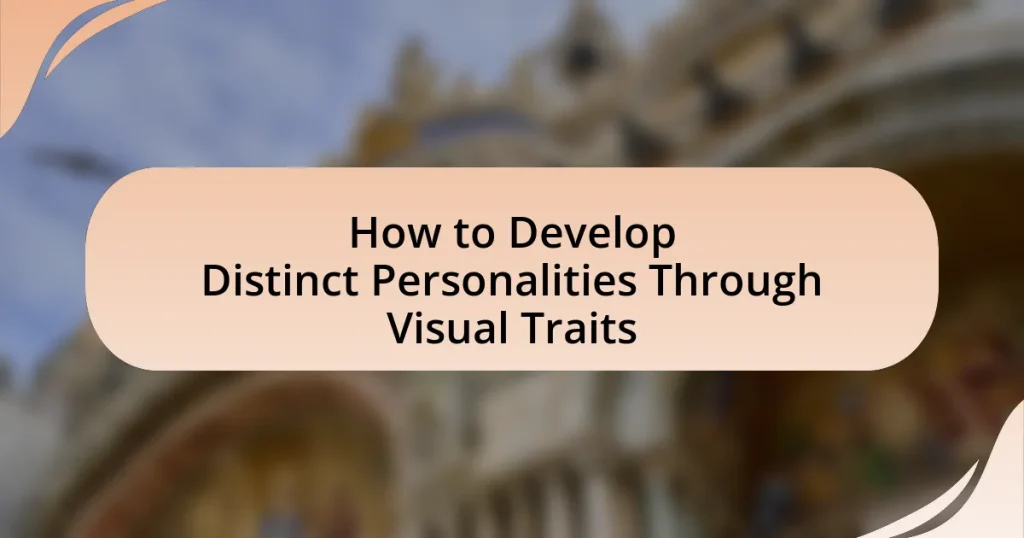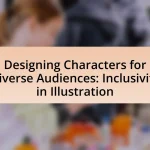The article focuses on the development of distinct personalities through visual traits, which encompass observable characteristics such as facial features, body language, and style of dress. It explores how these traits influence personality development, perceptions of self and others, and social interactions. Key topics include the impact of visual traits on first impressions, the association between specific traits and personality types, cultural interpretations of visual cues, and techniques for enhancing personal branding through visual identity. Additionally, the article discusses strategies for adapting visual traits over time to reflect personal growth and the psychological effects of color and fashion on personality representation.
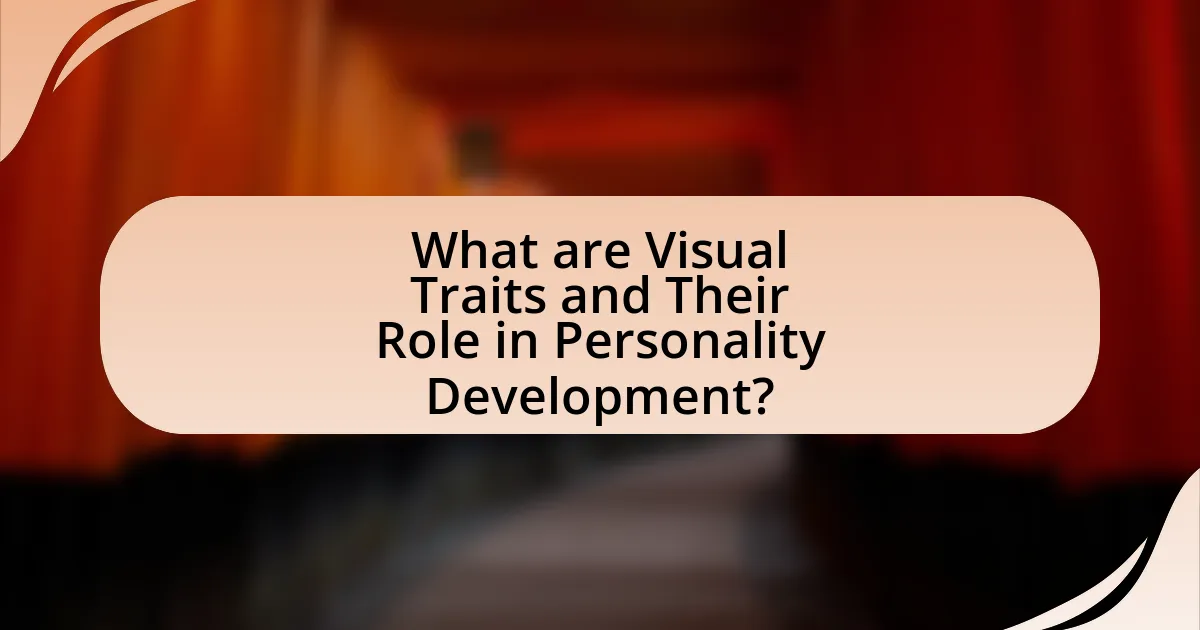
What are Visual Traits and Their Role in Personality Development?
Visual traits are the observable characteristics of an individual, such as facial features, body language, and style of dress, which significantly influence personality development. These traits serve as non-verbal cues that communicate emotions, social status, and personal identity, impacting how individuals perceive themselves and how they are perceived by others. Research indicates that visual traits can shape social interactions and self-esteem, as individuals often adjust their behavior based on the feedback they receive from their appearance. For instance, studies have shown that people who perceive themselves as attractive tend to exhibit higher levels of confidence and social engagement, reinforcing the connection between visual traits and personality development.
How do visual traits influence perceptions of personality?
Visual traits significantly influence perceptions of personality by shaping first impressions and guiding social judgments. Research indicates that individuals often make quick assessments of personality based on visual cues such as facial expressions, body language, and overall appearance. For instance, a study published in the journal “Psychological Science” by Rule and Ambady (2008) found that observers could accurately infer traits like trustworthiness and competence from facial features alone. This demonstrates that visual traits serve as powerful indicators, leading people to form opinions about others’ personalities even before verbal communication occurs.
What specific visual traits are commonly associated with certain personalities?
Specific visual traits commonly associated with certain personalities include clothing style, grooming habits, and body language. For instance, individuals with a creative personality often exhibit vibrant clothing choices and unique accessories, reflecting their artistic nature. In contrast, those with a more analytical personality may prefer structured, professional attire that conveys seriousness and competence. Research by psychologist Jennifer Aaker indicates that personality traits can influence visual self-presentation, with extroverts often displaying more expressive body language and open postures, while introverts may adopt more reserved stances. These associations highlight how visual traits can serve as indicators of underlying personality characteristics.
How do cultural differences affect the interpretation of visual traits?
Cultural differences significantly influence the interpretation of visual traits by shaping perceptions, meanings, and associations attached to those traits. For instance, in Western cultures, direct eye contact is often interpreted as confidence and honesty, while in some Asian cultures, it may be viewed as disrespectful or confrontational. This divergence in interpretation highlights how cultural context can alter the understanding of visual cues. Additionally, research by Matsumoto and Hwang (2013) in “Cultural Differences in the Interpretation of Nonverbal Behavior” demonstrates that nonverbal signals, including facial expressions and body language, are perceived differently across cultures, affecting interpersonal communication and social interactions. Thus, cultural frameworks play a crucial role in how visual traits are understood and valued.
Why is it important to develop distinct personalities through visual traits?
Developing distinct personalities through visual traits is important because it enhances individual identity and facilitates recognition in social contexts. Distinct visual traits, such as unique clothing styles, colors, or accessories, allow individuals to express their personality and differentiate themselves from others. Research indicates that visual cues significantly influence first impressions and social interactions, as people often rely on visual information to form judgments about character and compatibility. For example, a study published in the Journal of Personality and Social Psychology found that individuals can accurately assess personality traits based on visual appearance alone, highlighting the impact of visual traits on social perception.
What benefits do distinct visual personalities provide in social interactions?
Distinct visual personalities enhance social interactions by facilitating recognition and differentiation among individuals. This differentiation allows for quicker identification of social roles and intentions, which can lead to more effective communication. For instance, research indicates that individuals with unique visual traits are often perceived as more approachable and memorable, fostering stronger interpersonal connections. A study published in the Journal of Personality and Social Psychology found that distinctive appearances can influence first impressions, leading to increased trust and likability in social settings. Thus, distinct visual personalities not only aid in social navigation but also contribute to the establishment of meaningful relationships.
How can visual traits enhance personal branding and identity?
Visual traits enhance personal branding and identity by creating a recognizable and memorable image that communicates values and personality. For instance, consistent use of colors, logos, and styles in personal branding materials can evoke specific emotions and associations, making an individual stand out in a crowded market. Research indicates that 93% of communication is non-verbal, highlighting the importance of visual elements in conveying messages effectively. Additionally, a study by the University of California found that people form first impressions within milliseconds based on visual cues, underscoring how visual traits can significantly influence perceptions of credibility and professionalism.
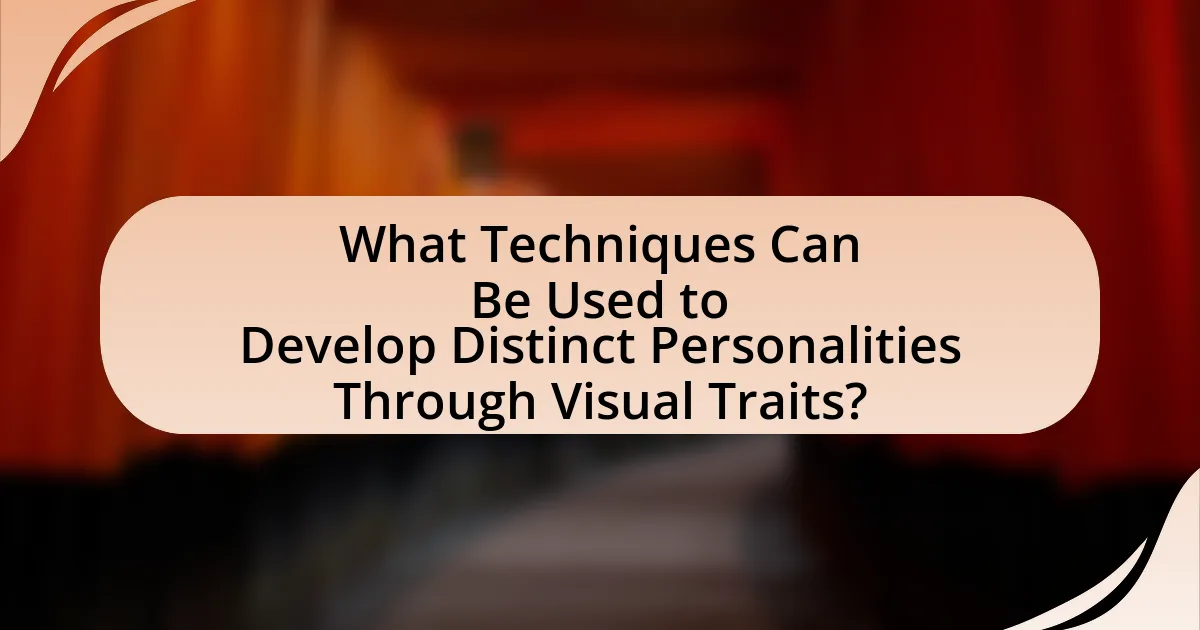
What Techniques Can Be Used to Develop Distinct Personalities Through Visual Traits?
Techniques to develop distinct personalities through visual traits include the use of color psychology, facial expressions, body language, and clothing styles. Color psychology suggests that different colors evoke specific emotions and associations; for example, red can signify passion or aggression, while blue often represents calmness and trust. Facial expressions convey emotions and can be manipulated to reflect personality traits, such as a smile indicating friendliness or a frown suggesting seriousness. Body language, including posture and gestures, can further enhance personality portrayal; open stances may suggest confidence, while closed stances may indicate insecurity. Additionally, clothing styles can reflect individual personality traits, with casual attire often associated with laid-back personalities and formal wear linked to professionalism. These techniques are supported by psychological studies that demonstrate the impact of visual cues on perception and interpretation of personality.
How can color choices impact personality perception?
Color choices significantly impact personality perception by influencing how individuals are viewed in terms of traits such as warmth, confidence, and creativity. For instance, research indicates that colors like red are often associated with energy and passion, while blue conveys trust and calmness. A study published in the journal “Color Research and Application” by Andrew Elliot and Markus Maier found that individuals wearing red were perceived as more dominant and attractive, whereas those in blue were seen as more reliable and peaceful. This demonstrates that color not only affects aesthetic appeal but also shapes social judgments and interactions based on perceived personality traits.
What psychological effects do different colors have on personality representation?
Different colors have significant psychological effects on personality representation, influencing emotions and behaviors. For instance, red is often associated with passion and energy, while blue conveys calmness and trustworthiness. Research indicates that individuals who prefer warm colors like red and orange may exhibit extroverted traits, whereas those drawn to cool colors like blue and green often display introverted characteristics. A study published in the journal “Color Research and Application” by Andrew Elliot and Markus Maier found that color preferences can correlate with personality traits, supporting the idea that colors can reflect and shape personality representation.
How can one select colors that align with desired personality traits?
To select colors that align with desired personality traits, one should first identify the specific traits they wish to embody, such as calmness, energy, or creativity. For instance, blue is often associated with calmness and trust, while red is linked to energy and passion. Research indicates that colors can evoke emotional responses and influence perceptions; for example, a study published in the journal “Color Research and Application” found that colors like yellow can enhance feelings of happiness and optimism. By understanding these associations, individuals can choose colors that reflect and reinforce their desired personality traits effectively.
What role does fashion play in expressing personality visually?
Fashion serves as a powerful medium for visually expressing personality by allowing individuals to curate their appearance in ways that reflect their identity, values, and emotions. Through choices in clothing, accessories, and style, people communicate aspects of their personality, such as creativity, confidence, or social status. For instance, research indicates that clothing can influence perceptions of personality traits; a study published in the Journal of Experimental Social Psychology found that individuals wearing formal attire are often perceived as more competent and authoritative. This demonstrates that fashion not only reflects personal identity but also shapes how others perceive that identity, reinforcing the significant role it plays in visual self-expression.
How can clothing styles reflect individual personality traits?
Clothing styles can reflect individual personality traits by serving as a visual representation of one’s identity, preferences, and values. For instance, research indicates that people often choose clothing that aligns with their self-image and social identity, such as wearing casual attire to express a laid-back personality or formal wear to convey professionalism and ambition. A study published in the Journal of Research in Personality found that individuals who prefer bold colors and unique styles tend to score higher on traits like openness to experience, while those who favor classic, muted tones often exhibit traits associated with conscientiousness. This correlation between clothing choices and personality traits underscores how fashion can be a powerful medium for self-expression and identity formation.
What are some tips for choosing outfits that convey specific personalities?
To choose outfits that convey specific personalities, individuals should focus on color, style, and accessories that align with the desired traits. For example, bright colors and bold patterns often reflect a vibrant and outgoing personality, while neutral tones and minimalist designs may suggest a more reserved or professional demeanor. Additionally, incorporating specific styles, such as bohemian or preppy, can further emphasize particular personality traits. Research indicates that clothing choices significantly influence first impressions, with studies showing that people often make judgments about personality based on attire within seconds. Therefore, selecting outfits that resonate with one’s intended personality can effectively communicate that identity to others.
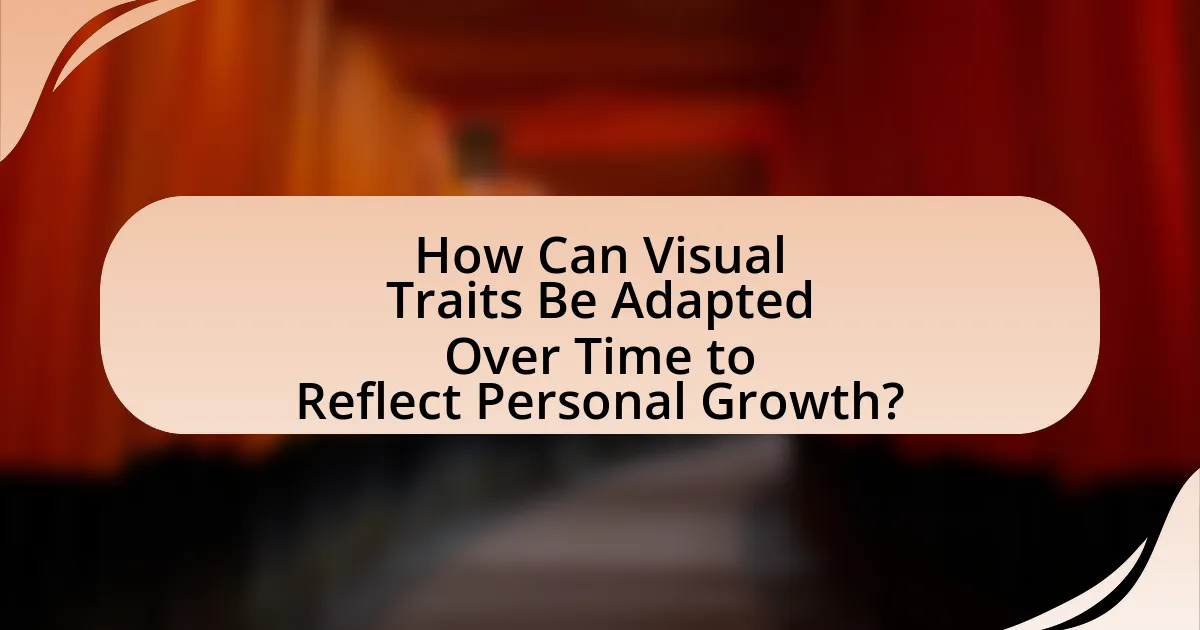
How Can Visual Traits Be Adapted Over Time to Reflect Personal Growth?
Visual traits can be adapted over time to reflect personal growth by consciously altering elements such as clothing, hairstyle, and body language to align with evolving self-identity and values. For instance, an individual may choose to wear more vibrant colors or unique styles as they gain confidence, signaling a shift in their self-perception. Research indicates that personal expression through visual traits can enhance self-esteem and reinforce identity, as seen in studies like “The Role of Personal Appearance in Self-Concept” by Cash and Smolak, which highlights the connection between visual representation and self-identity. Thus, adapting visual traits serves as a tangible manifestation of personal development and self-awareness.
What strategies can be employed to evolve visual traits as personalities change?
To evolve visual traits as personalities change, individuals can adopt strategies such as altering clothing styles, modifying hairstyles, and adjusting color palettes. These changes can reflect shifts in personal identity and emotional states, as evidenced by studies showing that clothing choices significantly influence self-perception and social interactions. For instance, research published in the Journal of Experimental Social Psychology indicates that individuals who wear formal attire tend to feel more powerful and confident, which can lead to a transformation in their visual presentation. Additionally, using color psychology, individuals can select hues that resonate with their current emotional state, thereby reinforcing their evolving personality.
How can one assess the effectiveness of visual traits in representing their personality?
One can assess the effectiveness of visual traits in representing their personality by analyzing the alignment between visual attributes and self-reported personality characteristics. Research indicates that individuals often use visual cues, such as clothing, hairstyle, and body language, to convey aspects of their personality, which can be measured through surveys and observational studies. For instance, a study published in the Journal of Personality and Social Psychology found that observers could accurately infer personality traits based on visual cues, demonstrating a significant correlation between visual representation and perceived personality. This evidence supports the assessment of visual traits as effective indicators of personality.
What are common challenges faced when adapting visual traits?
Common challenges faced when adapting visual traits include maintaining consistency across different mediums and ensuring cultural relevance. Consistency is crucial because visual traits must align with the intended personality across various platforms, such as digital and print, to avoid confusion. Cultural relevance is essential as visual traits must resonate with the target audience’s values and norms; failing to consider cultural context can lead to misinterpretation or offense. For example, a study by the American Psychological Association highlights that visual elements can significantly influence perception and behavior, emphasizing the importance of thoughtful adaptation in visual communication.
What practical steps can be taken to develop distinct personalities through visual traits?
To develop distinct personalities through visual traits, individuals can utilize specific strategies such as color psychology, unique fashion choices, and personalized grooming. Color psychology indicates that different colors evoke various emotions and perceptions; for instance, red can signify passion while blue may convey calmness. By selecting colors that align with the desired personality traits, individuals can visually communicate their identity. Unique fashion choices, such as distinctive styles or accessories, can further enhance personal expression, allowing individuals to stand out and reflect their individuality. Additionally, personalized grooming, including hairstyles and makeup, can reinforce a specific persona, making visual traits more cohesive. These methods are supported by studies in psychology and fashion, which demonstrate the impact of visual elements on personal branding and perception.
How can one create a visual identity that resonates with their true self?
To create a visual identity that resonates with one’s true self, an individual should first identify their core values, interests, and personality traits. This foundational understanding allows for the selection of colors, shapes, and styles that authentically represent them. For instance, research indicates that colors evoke specific emotions and associations; blue often conveys trust and calmness, while red can signify passion and energy. By aligning visual elements with personal attributes, individuals can craft a cohesive identity that reflects their essence. Additionally, consistency across various platforms, such as social media and personal branding materials, reinforces this identity, making it recognizable and relatable.
What resources are available for individuals looking to enhance their visual personality traits?
Individuals looking to enhance their visual personality traits can utilize various resources such as personal styling services, online courses, and social media platforms. Personal styling services provide tailored advice on clothing, accessories, and grooming that align with an individual’s desired visual persona. Online courses, such as those offered by platforms like Skillshare or Udemy, focus on topics like color theory, body language, and personal branding, which are essential for developing a distinct visual identity. Social media platforms, particularly Instagram and Pinterest, serve as visual inspiration hubs where individuals can explore trends, styles, and aesthetics that resonate with their personality goals. These resources collectively support individuals in crafting a visual representation that reflects their unique traits and aspirations.
